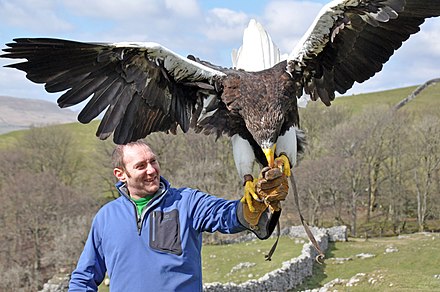The Steller’s Sea Eagle (Haliaeetus pelagicus) is the largest and heaviest known eagle, with a dark body, strongly arched yellow bill, and distinctive white markings on its forehead, shoulders, thighs, and tail. These majestic birds are native to the coastal regions of northeastern Asia, including Russia, Korea, Japan, China, and Taiwan, where they primarily inhabit river and coastal habitats.
Courtship and Nesting
The Steller’s Sea Eagle’s life cycle begins with courtship, which typically occurs between February and March. During this time, pairs of sea eagles engage in a soaring flight display above their breeding territory. These eagles are believed to remain paired for life, although this has not been definitively confirmed.
Once the courtship rituals are complete, the eagles begin building their nests. These are large, bulky structures made of twigs and sticks, measuring up to 1.5 m (59 in) in height and 2.5 m (98 in) in diameter. The nests are usually placed high up on trees or on rocky outcrops, at an elevation of 15 to 20 m (49 to 66 ft) above the ground.
Egg Laying and Incubation
 Image source: stellers sea eagle
Image source: stellers sea eagle
Females of the Steller’s Sea Eagle species lay their greenish-white eggs around April to May. The clutch size typically ranges from 1 to 3 eggs, but usually, only one chick survives to adulthood. The eggs undergo an incubation period of approximately 39 to 45 days before hatching.
Hatching and Fledging
When the eaglets hatch, they are altricial, meaning they are born helpless and covered in whitish-down. The chicks remain in the nest, being cared for and fed by their parents, until they fledge, or take their first flight, in August or early September.
Maturation and Feeding Habits
Steller’s Sea Eagles attain their adult plumage at around 4 years of age, but they typically do not begin breeding until they are 5 or 6 years old. These birds are primarily carnivorous and piscivorous, with a diet that consists mainly of fish, particularly salmon and trout. They also occasionally consume water birds, land birds, mammals, and carrion.
Threats and Conservation
The Steller’s Sea Eagle faces several threats to its survival, including habitat alteration, industrial pollution, and overfishing, which can decrease their prey sources. Additionally, recent heavy flooding, potentially caused by global climate change, has led to almost complete nesting failure for eagles nesting in Russian rivers. Persecution of the bird in Russia also continues due to its habit of stealing furbearers from trappers.
Despite these challenges, conservation efforts are underway to protect the Steller’s Sea Eagle. Organizations and governments in the bird’s native range are working to monitor populations, enforce anti-poaching laws, and promote sustainable fishing practices to ensure the long-term survival of this magnificent species.
References:
– https://animals.sandiegozoo.org/animals/stellers-sea-eagle
– https://animalia.bio/stellers-sea-eagle
– https://en.wikipedia.org/wiki/Steller%27s_sea_eagle
– https://www.zoonewengland.org/franklin-park-zoo/our-animals/birds/steller-s-sea-eagle/

